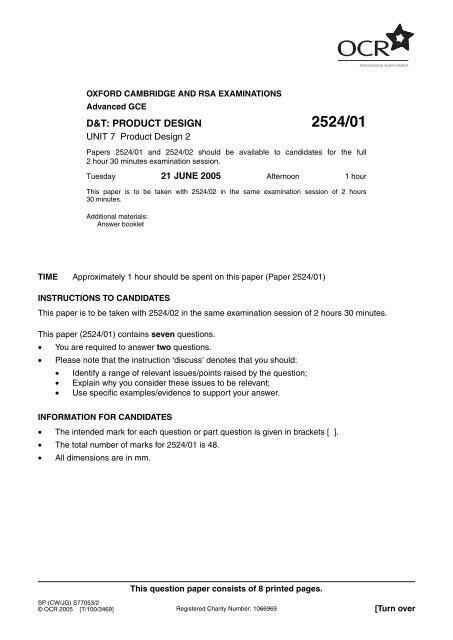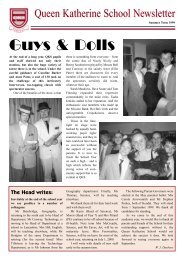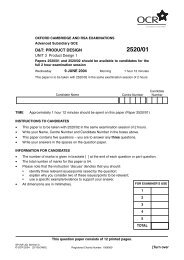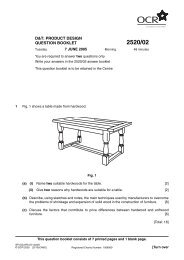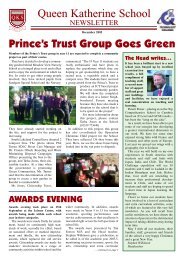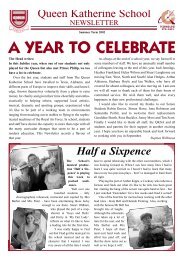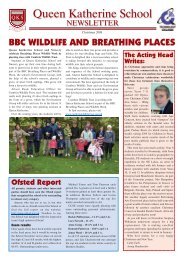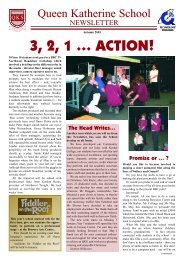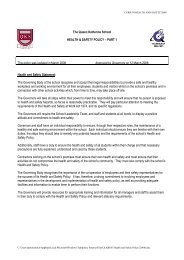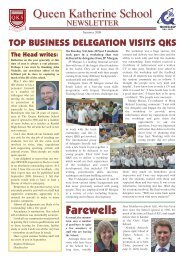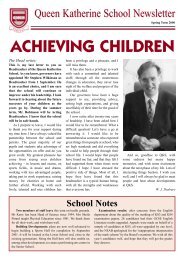01 Question Paper Jun 05 - Queen Katherine School
01 Question Paper Jun 05 - Queen Katherine School
01 Question Paper Jun 05 - Queen Katherine School
Create successful ePaper yourself
Turn your PDF publications into a flip-book with our unique Google optimized e-Paper software.
OXFORD CAMBRIDGE AND RSA EXAMINATIONS<br />
Advanced GCE<br />
D&T: PRODUCT DESIGN 2524/<strong>01</strong><br />
UNIT 7 Product Design 2<br />
<strong>Paper</strong>s 2524/<strong>01</strong> and 2524/02 should be available to candidates for the full<br />
2 hour 30 minutes examination session.<br />
Tuesday 21 JUNE 20<strong>05</strong> Afternoon 1 hour<br />
This paper is to be taken with 2524/02 in the same examination session of 2 hours<br />
30 minutes.<br />
Additional materials:<br />
Answer booklet<br />
TIME Approximately 1 hour should be spent on this paper (<strong>Paper</strong> 2524/<strong>01</strong>)<br />
INSTRUCTIONS TO CANDIDATES<br />
This paper is to be taken with 2524/02 in the same examination session of 2 hours 30 minutes.<br />
This paper (2524/<strong>01</strong>) contains seven questions.<br />
• You are required to answer two questions.<br />
• Please note that the instruction ‘discuss’ denotes that you should:<br />
• Identify a range of relevant issues/points raised by the question;<br />
• Explain why you consider these issues to be relevant;<br />
• Use specific examples/evidence to support your answer.<br />
INFORMATION FOR CANDIDATES<br />
• The intended mark for each question or part question is given in brackets [ ].<br />
• The total number of marks for 2524/<strong>01</strong> is 48.<br />
• All dimensions are in mm.<br />
SP (CW/JG) S77<strong>05</strong>3/2<br />
This question paper consists of 8 printed pages.<br />
© OCR 20<strong>05</strong> [T/100/3469] Registered Charity Number: 1066969<br />
[Turn over
2<br />
You are required to answer two questions.<br />
Answer the questions in the separate answer booklet.<br />
1 Fig. 1 shows a self-assembly computer workstation.<br />
Fig. 1<br />
(a) (i) Name two manufactured boards that could be used for this type of self assembly<br />
furniture. [2]<br />
(ii)<br />
(iii)<br />
Describe, using annotated sketches, how one of these boards has been constructed to<br />
provide its strength. [2]<br />
Describe, using annotated sketches, two ways in which the edges of manufactured<br />
boards could be finished after being cut. [4]<br />
(b) (i) Describe, using annotated sketches, two KD (knock-down) fittings used to join pieces of<br />
self assembly furniture. [4]<br />
(ii)<br />
Explain how anthropometric data would be used in the design of a home-based<br />
computer workstation. [4]<br />
(c)<br />
Discuss the factors that have influenced the increased availability of self-assembly furniture.<br />
[8]<br />
2524/<strong>01</strong> <strong>Jun</strong><strong>05</strong>
3<br />
2 Fig. 2 shows a bicycle frame.<br />
Fig. 2<br />
(a) (i) Name two specific metals that are used in the manufacture of bicycle frames. [2]<br />
(ii) Give two reasons why metal bicycle frames often have a spray painted finish. [2]<br />
(iii)<br />
Use annotated sketches to identify two different forces that act within the bicycle frame,<br />
shown in Fig. 2, when it is in use. [4]<br />
(b)<br />
Fig. 2 shows a metal bicycle frame where the components have been brazed together.<br />
(i)<br />
(ii)<br />
Describe, using annotated sketches, how the frame would be set up prior to joining, to<br />
ensure a consistency of shape. [4]<br />
Describe, using annotated sketches, the brazing process used in the assembly of one of<br />
the joints in the bicycle frame. [4]<br />
(c)<br />
Discuss the influence of modern materials on the development of high performance sports<br />
equipment. [8]<br />
2524/<strong>01</strong> <strong>Jun</strong><strong>05</strong> [Turn over
3 Fig. 3 shows a plastic packet used to retail sandwiches.<br />
4<br />
Fig. 3<br />
(a) (i) Name two thermoplastics that are suitable for sandwich packets. [2]<br />
(ii) Give two reasons why thermoplastics are suitable for sandwich packets. [2]<br />
(iii)<br />
In use, the packet shown in Fig. 3, was found to be too flexible and the contents were<br />
often damaged.<br />
Describe, using annotated sketches, two ways of stiffening the plastic packet. [4]<br />
The sandwich packets are vacuum formed using a high volume continuous flow production<br />
method.<br />
(b)<br />
Describe, using annotated sketches, how the sandwich packets could be vacuum formed<br />
using a high volume continuous flow method. [8]<br />
Many items of packaging are made from non-renewable resources.<br />
(c) Discuss the environmental implications of using non-renewable resources. [8]<br />
2524/<strong>01</strong> <strong>Jun</strong><strong>05</strong>
5<br />
4 Fig. 4 shows a design for a point of sale display made from card. The display includes a pop-up<br />
mechanism.<br />
‘pop up’<br />
mechanism<br />
pot rises<br />
pull<br />
pull<br />
pull<br />
tab pulled<br />
down<br />
POS display<br />
Fig. 4<br />
(a) (i) Name two printing processes that could be used to print this point of sale display in<br />
colour. [2]<br />
(ii) Give two reasons why companies use point of sale displays. [2]<br />
(iii)<br />
Give four reasons, other than cost, why board is a suitable material to produce a point of<br />
sale display. [4]<br />
(b) Describe, using annotated sketches, the construction of the pop-up mechanism shown in Fig. 4.<br />
Include details of:<br />
• Jointing techniques<br />
• Guides<br />
• Stops<br />
• Surface detail [8]<br />
(c)<br />
Discuss the implications of using ICT during the development of publicity for a new product.<br />
[8]<br />
2524/<strong>01</strong> <strong>Jun</strong><strong>05</strong> [Turn over
5 Fig. 5 shows a box used for washing machine powder.<br />
6<br />
plastic<br />
handle<br />
Fig. 5<br />
(a)<br />
The box in Fig. 5 is made from duplex board.<br />
(i) Draw a labelled cross section of duplex board. [2]<br />
(ii) Give two reasons why duplex board is a suitable material to produce the box. [2]<br />
(iii) Draw and label two printer’s marks used for quality control during the manufacture. [4]<br />
(b)<br />
(c)<br />
Sketch, to suitable proportions, a net of the box shown in Fig. 5. Include all manufacturing<br />
details. [8]<br />
Discuss the implications for the design of packaging to enable a reduction in the volume of<br />
disposable waste. [8]<br />
2524/<strong>01</strong> <strong>Jun</strong><strong>05</strong>
6 Fig. 6 shows a cotton towelling dressing gown.<br />
7<br />
Fig. 6<br />
(a) (i) Give three reasons why a cotton towelling fabric is suitable for a dressing gown. [3]<br />
(ii)<br />
(iii)<br />
Cotton towelling is a looped pile fabric. Describe, using annotated sketches, the structure<br />
of a looped pile fabric. [3]<br />
Name two finishes which would enhance the performance of the dressing gown fabric.<br />
[2]<br />
(b)<br />
Describe, using a detailed flow chart supported by annotated sketches, the order of making<br />
and attaching one pocket to the dressing gown. [8]<br />
(c) Discuss the implications of using recycled materials in the manufacture of textile products. [8]<br />
2524/<strong>01</strong> <strong>Jun</strong><strong>05</strong> [Turn over
7 Fig. 7 shows a sleeping bag with a ‘stuffsack’ for storage.<br />
8<br />
sleeping bag<br />
‘stuff sack’<br />
Fig. 7<br />
(a) (i) Name two fibres that could be used to make the outer fabric of the sleeping bag. [2]<br />
(ii)<br />
List three performance characteristics needed by the outer fabric of the sleeping bag.<br />
[3]<br />
(iii) Explain what is meant by the term ‘tog’ rating. [2]<br />
(iv) Give one reason tog ratings are important to the consumer. [1]<br />
(b)<br />
(c)<br />
Describe, using a detailed flow chart supported by annotated sketches, the order of<br />
manufacture of the stuff sack. Include all pattern pieces and components. [8]<br />
Discuss the impact of technological developments in the manufacture of textile products<br />
designed for outdoor use. [8]<br />
2524/<strong>01</strong> <strong>Jun</strong><strong>05</strong>


